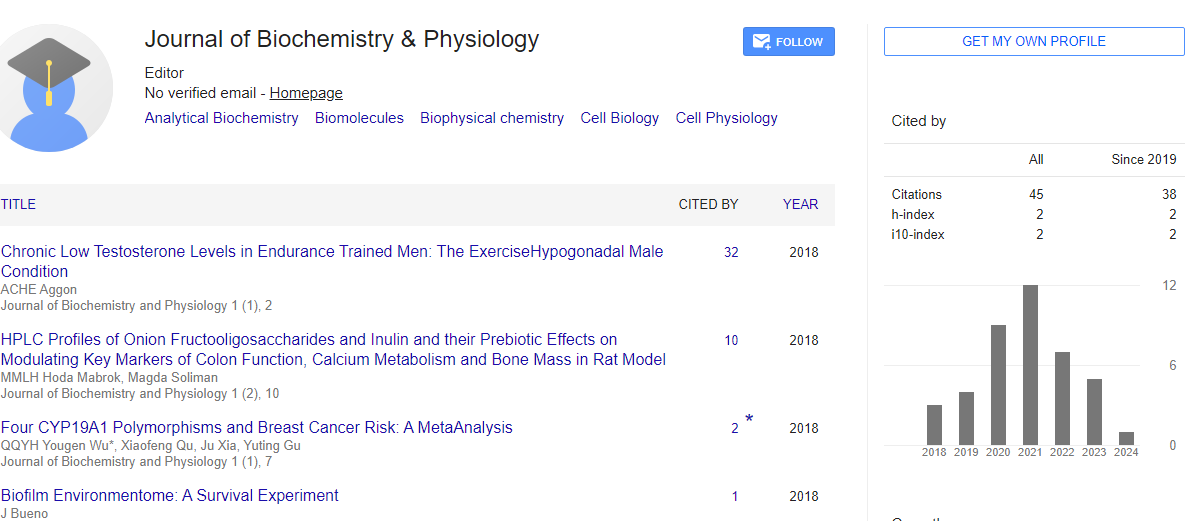Opinion Article, J Biochem Physiol Vol: 6 Issue: 2
Probing the Immune System: Exploring Enzyme-Linked Immunosorbent Assays (ELISA)
Fadel Rios*
1Department of Immunology, Juntendo University, Tokyo, Japan
*Corresponding Author: Fadel Rios,
Department of Immunology, Juntendo
University, Tokyo, Japan
E-mail: fadel.rio@med.ac.jp
Received date: 29 May, 2023, Manuscript No. JBPY-23-110493;
Editor assigned date: 31 May, 2023, PreQC No. JBPY-23-110493 (PQ);
Reviewed date: 14 June, 2023, QC No. JBPY-23-110493;
Revised date: 21 June, 2023, Manuscript No. JBPY-23-110493 (R);
Published date: 28 June, 2023 DOI: 10.4172/jbpy.1000140.
Citation: Rios F (2023) Probing the Immune System: Exploring Enzyme-Linked Immunosorbent Assays (ELISA). J Biochem Physiol 6:2.
Abstract
Complementary energy supplies Enzyme-Linked Immunosorbent Assays (ELISA) have become an indispensable tool in modern biomedical research and clinical diagnostics. This manuscript provides an in-depth exploration of ELISA, covering its principles, different types, and a range of applications. It discusses the underlying mechanisms, experimental procedures, and potential challenges associated with ELISA. Furthermore, it highlights the significant impact of ELISA in disease detection, antibody profiling, and drug development.
Description
Complementary energy supplies Enzyme-Linked Immunosorbent Assays (ELISA) have become an indispensable tool in modern biomedical research and clinical diagnostics. This manuscript provides an in-depth exploration of ELISA, covering its principles, different types, and a range of applications. It discusses the underlying mechanisms, experimental procedures, and potential challenges associated with ELISA. Furthermore, it highlights the significant impact of ELISA in disease detection, antibody profiling, and drug development.
Enzyme-Linked Immunosorbent Assays (ELISA) have revolutionized the field of immunology and molecular biology since their development in the 1970s. This manuscript aims to elucidate the principles of ELISA and present its diverse applications across various scientific domains.
ELISA principles
ELISA is based on the specific interaction between an antigen and an antibody. The assay involves immobilizing one of these components (either antigen or antibody) onto a solid support and subsequently detecting the binding through enzymatic reactions. The most common formats of ELISA include direct, indirect, sandwich, and competitive ELISAs.
Types of ELISA
Direct ELISA: In this format, the antigen is immobilized on a surface, and a labeled antibody is used for detection. The binding of the labeled antibody indicates the presence of the target antigen.
Indirect ELISA: Involves the immobilization of the primary antibody, followed by the addition of a labeled secondary antibody that recognizes the primary antibody. This format is advantageous for detecting low-abundance antigens.
Sandwich ELISA: Utilizes two specific antibodies one for capture and another for detection to sandwich the target antigen between them. This format offers high sensitivity and specificity..
Competitive ELISA: Involves competition between a labeled antigen and an unlabeled antigen for binding to a limited amount of antibody. The degree of inhibition indicates the concentration of the target antigen.
ELISA applications
Clinical diagnostics: ELISA is extensively used in clinical laboratories for detecting a wide range of diseases, including infectious diseases (HIV, hepatitis), autoimmune disorders (lupus, rheumatoid arthritis), and cancer markers (prostate-specific antigen, CA125).
Antibody profiling: ELISA can quantify and characterize antibody responses to antigens, aiding vaccine development and immunological research.
Drug development: ELISA plays a vital role in screening and monitoring drug compounds, measuring drug levels in patient samples, and evaluating biomarkers.
Environmental monitoring: ELISA is employed to detect pollutants, toxins, and pathogens in environmental samples, ensuring food safety and water quality.
Experimental procedures
Plate coating: The surface of the microtiter plate is coated with the capture antibody or antigen.
Blocking: Non-specific binding sites are blocked to prevent falsepositive results.
Sample addition: Patient samples or standards containing the target antigen are added to the plate.
Detection: The detection antibody, usually labeled with an enzyme, binds to the target antigen.
Substrate addition: Enzyme-substrate reaction produces a signal (e.g., color change) that is quantified using a spectrophotometer.
Data analysis: The concentration of the target antigen is determined based on a standard curve.
Challenges and considerations
Sensitivity and specificity: Optimizing assay conditions is crucial to achieve high sensitivity and specificity.
Cross-reactivity: Careful selection of antibodies and antigens is necessary to avoid cross-reactivity.
Standardization: Developing a robust standard curve and using calibrated controls ensure accurate quantification.
Automation: Automated ELISA platforms improve throughput and minimize operator variability.
Conclusion
Enzyme-Linked Immunosorbent Assays (ELISA) continue to be a cornerstone in biomedical research and clinical diagnostics. Their versatility, sensitivity, and ability to quantify analytes have made them an essential tool across multiple scientific disciplines. ELISA's impact on disease detection, antibody profiling, and drug development is undeniable, and ongoing advancements in technology will likely expand its applications even further.
 Spanish
Spanish  Chinese
Chinese  Russian
Russian  German
German  French
French  Japanese
Japanese  Portuguese
Portuguese  Hindi
Hindi 